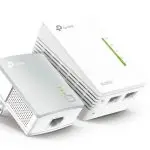
tp-link Powerline WiFi Extender Installation Guide
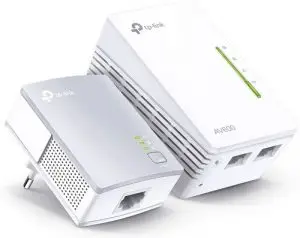
- TL-WPA4220 KIT (European version) is used for demonstration in this guide.
- Images may differ from actual products.
Plug and Play
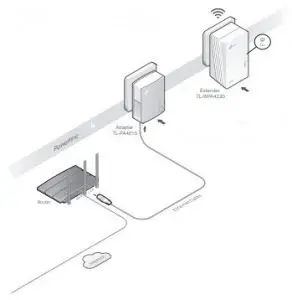
- Plug the adapter into a power outlet and connect it to the router’s LAN port via an Ethernet cable.
- Plug the extender into a power outlet on the same electrical circuit. Wait until the extender’s Power line LED
 turns on.
turns on.
Note: If the LED is blanking or off, please refer to FAQ>Q2. - Enjoy!
Connect your devices to the internet using the default SSID (network name) and password on the label at the top of the extender.
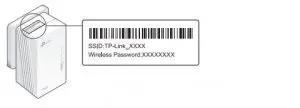
Tip: Want to unify Wi-Fi networks or personalize your network? See the back page for instructions.
Attention
- Use the product only in the upright direction.

- Plug power line devices into wall outlets instead of power strips. Using power strip will affect network performance or even cause connection drops.

Unify Your Wi-Fi Networks via WPS
Copy SSID and password from your router via WPS to create one unified Wi-Fi network throughout your home.
Note: If your router doesn’t have a WPS button, manually change the extender’s Wi-Fi settings via the tpPLC app, tpPLC Utility, or web interface.
- Plug in the extender in the same room as your router. Wait until the extender’s Wi-Fi LED turns
 on.
on. - Press your router’s WPS button. Within 2 minutes, press the extender’s Wi-Fi button for 1 second. The extender’s Wi-Fi LED
 starts blinking. When it stays on, Wi-Fi settings are copied.
starts blinking. When it stays on, Wi-Fi settings are copied.
Note: If Wi-Fi settings are not copied within 2 minutes, manually change the extender’s Wi-Fi settings. - Relocate the extender and enjoy the internet using your router’s SSID and password.

Create a Secure Powerline Network by Pairing
Note: You can only pair two devices at a time. We recommend that you plug in the powerline devices near each other when pairing.
Pair the Powerline Devices
- Press the Pair button on the adapter for 1 second. Its Power LED
 starts blinking.
starts blinking.
Note: If the Power LED does not blink, press the Pair button again. - Within 2 minutes, press the extender’s Pair button for 1 second. Its Power LED
 starts blinking.
starts blinking. - When the extender’s Powerline LED
 turns on, the pairing process is complete.
turns on, the pairing process is complete.
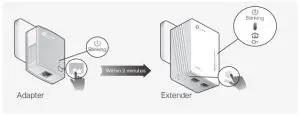
Sync Wi-Fi Settings to More Extenders
If you have more extenders, simply plug in and pair each one with the existing adapter to join the network. Then the Wi-Fi settings will automatically sync from the existing extender to the new ones.
Button Legend
Extender TL-WPA4220
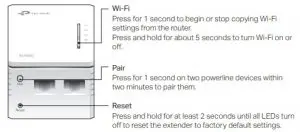

TP-Link OneMesh router and extenders work together to form one unified Wi-Fi network. Walk through your home and stay connected with the fastest possible speeds thanks to OneMesh’s seamless coverage.
 Unified Wi-Fi Network
Unified Wi-Fi Network
Router and extenders share the same wireless settings, including network name, password, access control settings and more.
 Seamless Roaming
Seamless Roaming
Devices automatically switch between your router and extenders as you move through your home for the fastest possible speeds.
 Easy Setup and Management
Easy Setup and Management
Set up a OneMesh network with a push of WPS buttons. Manage all network devices on the Tether app or at your router’s web management page.
To check full list of TP-Link OneMesh devices, scan the QR code,
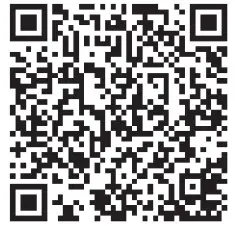
or visit https://www.tp-link.com/One-Mesh/compatibility.
Personalize Your Network
tpPLC App
For easy management via your smartphone or tablet, download the app from the App Store or Google Play, or simply scan the QR code.
 |
 |
| Scan to download | tpPLC App |
https://www.tp-link.com/app/qrcode/?app=tp-plc
tpPLC Utility
For easy management via your computer, download the utility on the product’s Support page at https://www.tp-link.com.
Note: For detailed instructions, refer to the utility manual on the product’s Support page.
Web Interface
To access all settings, connect to an extender wirelessly and visit http://tplinkplc.net.
Note: For detailed instructions, refer to the product manual on the product’s Support page.
Frequently Asked Questions
Q1. How do I reset my extender to factory default settings?
Ans. With the extender plugged into an electrical outlet, press and hold the Reset button until all LEDs turn off. When the LEDs turn back on, the reset process is complete.
Q2. What should I do if the Powerline LED is blinking or off?
is blinking or off?
If the LED is blinking:
Ans. The powerline device is in a location with a poor signal strength. Try another wall socket.
If the LED is off:
Ans1. Try another wall socket and make sure all powerline devices are on the same electrical circuit.
Ans2. Try to set up a powerline network by pairing. Refer to the section above for instructions.
Ans3. If the problem persists, contact our Technical Support.
Q3. What should I do if there is no internet connection in my powerline network?
Ans1. Make sure all powerline adapters and extenders are on the same electrical circuit.
Ans2. Make sure the Powerline LEDs are lit on all of your powerline devices. If they are not, pair all
are lit on all of your powerline devices. If they are not, pair all
devices again.
Ans3. Make sure all devices are correctly and securely connected.
Ans4. Check if you have an internet connection by connecting the computer directly to the modem or
router.
Q4. What should I do if a successfully-paired extender does not reconnect after it is relocated?
Ans1. Make sure all powerline adapters and extenders are on the same electrical circuit.
Ans2. Try to pair the extender again, and make sure the Powerline LED is on.
is on.
Ans3. Check for possible interference due to a washing machine, air conditioner or other household
appliances that may be too close to one of the powerline devices. Plug the appliance into the integrated electrical socket to remove the electrical noise if your powerline device has an integrated electrical socket.
 For technical support, the user guide and more information, please visit https://www.tp-link.com/support/, or simply scan the QR code.
For technical support, the user guide and more information, please visit https://www.tp-link.com/support/, or simply scan the QR code.

http://www.tp-link.com/support
TP-Link hereby declares that the device is in compliance with the essential requirements and other relevant provisions of directives 2014/53/EU, 2009/125/EC, 2011/65/EU and (EU)2015/863.The original EU declaration of conformity may be found at https://www.tp-link.com/en/ce.
Safety Information
- Keep the device away from water, fire, humidity or hot environments.
- Do not attempt to disassemble, repair, or modify the device.
- Do not use the device where wireless devices are not allowed.
- The socket-outlet shall be installed near the equipment and shall be easily accessible.
- Plug the powerline devices directly into the wall outlets but not the power strips.
